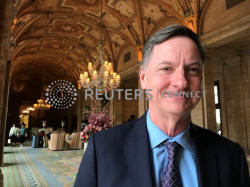Flattened yield curve reason to be nervous, but U.S.
economy solid: Fed's Evans
 Send a link to a friend
Send a link to a friend
 [March 25, 2019]
By Noah Sin [March 25, 2019]
By Noah Sin
HONG KONG (Reuters) - Chicago Federal
Reserve Bank President Charles Evans said on Monday it was
understandable for markets to be nervous when the yield curve flattened,
though he was still confident about the U.S. economic growth outlook.
In what many see as a bad omen for the economy, yields on benchmark U.S.
10-year treasury notes fell below three-month rates on Friday for the
first time since mid-2007, an inversion that has in the past signaled
the risk of recession.
After an unexpected rise in the Ifo Institute's March business climate
index in Germany, spreads between U.S. three-month and 10-year Treasury
yields turned positive.
Evans described the inversion as "pretty narrow".
"We have to take into account that there's been a secular decline in
long-term interest rates," Evans said in comments at the Credit Suisse
Asian Investment Conference in Hong Kong, days after the Fed signaled an
end to its tightening and abandoned plans for further rate hikes in
2019.

"Some of this is structural, having to do with lower trend growth, lower
real interest rates," he said. "I think, in that environment, it's
probably more natural that yield curves are somewhat flatter than they
have been historically."
On the sidelines of the conference, Evans told CNBC in an interview that
he could understand why investors were more "watchful, waiting and
looking," adding the Fed was doing the same. But, he added, economic
fundamentals were "good" and he expected growth to be around 2 percent
this year.
"Your first reaction is gonna (be) 'wow, this is less than what we had'
and I think this is missing the message."
The risk of a shock hitting the economy was not unusually higher or
lower at the moment, he later told reporters.
Speaking at the same event, former Fed chair Janet Yellen said the yield
curve may signal the need to cut interest rates at some point, but it
does not signal a recession.
"In contrast with times past, there’s a tendency now for the yield curve
to be very flat," Yellen, who led the Fed between 2014 and 2018, said.
TIME TO PAUSE
On the monetary policy outlook, Evans told the conference it was a good
time for the U.S. central bank to pause and adopt a cautious stance,
adding he did not expect any interest rate hikes until the second half
of next year.

[to top of second column] |

Charles Evans, president of the Federal Reserve Bank of Chicago,
poses for a photo in Palm Beach, Florida, U.S. January 17, 2018.
REUTERS/Ann Saphir

He said the labor market remained strong, but noted inflation expectations had
edged lower and there were risks related to weaker economic activity in China
and elsewhere, uncertainty over Brexit, and a waning impact of U.S. fiscal
stimulus.
Softening his tone from a few months ago, Evans, who votes on interest rate
policy this year, said monetary policy was neither accommodative, nor
restrictive at this point.
"I see things impeding inflation a bit, and I want to see inflation get up. So
my own path is not to expect a funds rate increase until next year, probably,
the second half," Evans said.
And even if prices do start to rise, he said, "given how muted inflationary
pressures appear today, a rise to 2.25 to 2.5 percent is not a big concern to me
at the moment."
That assessment suggests Evans has set the bar fairly high for further rate
hikes, considering that inflation by the Fed's preferred gauge has not been that
much above the Fed's 2-percent goal since before the financial crisis.
He added that with downside risks looming and uncertainties rife, it is prudent
for the Fed to wait for more economic data.
He also said a rate cut was a possibility if the economy softened even more or
inflation ran too low.

That echoed the view of fellow policymaker Atlanta Fed President Raphael Bostic,
who on Friday said both possibilities are on the table for him.
In January, Evans said the Fed could hike interest rates three times in 2019
assuming the U.S. economy remained reasonably strong.
Last week, the U.S. central bank left rates steady in a range of 2.25 percent to
2.5 percent. Fresh forecasts showed 11 of 17 Fed policymakers expected no rate
change for the rest of the year, up from just two in December.
That unexpectedly dovish signal had financial markets quickly pricing in a rate
cut next year.
(Reporting by Noah Sin; writing by Marius Zaharia; Editing by Darren Schuettler,
Kim Coghill & Simon Cameron-Moore)
[© 2019 Thomson Reuters. All rights
reserved.] Copyright 2019 Reuters. All rights reserved. This material may not be published,
broadcast, rewritten or redistributed.
Thompson Reuters is solely responsible for this content. |